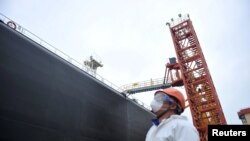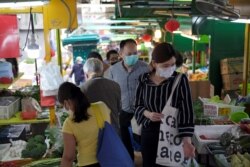Asian markets rose Friday after world leaders at the Group of 20 (G-20) virtual summit pledged to inject $5 trillion to stave off a global economic collapse and amid surging numbers of patients who have tested positive for the coronavirus outside China.
Shares in Japan led the region with the benchmark Nikkei 225 rising 3.88%.
Hong Kong's Hang Seng was up 0.56%, and China's Shanghai Composite rose 0.26%.
While China appears to be rebounding from its worst health crisis sooner than expected, economists are divided about whether it will embrace a V-shaped recovery as it did during the 2003 SARS epidemic.
V-shaped recovery?
"When the coronavirus hit, what we saw in February was a large decline [in China]. The good thing is, coming this March, this decline has reversed. So we have a reversal and we hope it will be a sharp V-shaped response going on," Li Wei, finance professor at the Cheung Kong Graduate School of Business (CKGSB), told a webinar Friday during a discussion about the impact of the virus on the Chinese economy.
Li was referring to the latest CKGSB business conditions index, which measures the business sentiment of private small- and medium-sized enterprises (SMEs) in China.
The monthly index has rebounded to 41.3 this month, from February's 37.3 — a historic low since the index's compilation in 2012 — and January's 56.2.
Its sharp decline in February reflected a "confidence crash" among Chinese SMEs, as the outbreak was expected to take a larger toll on the Chinese economy.
The reversed reading in March, however, is still below the threshold of 50 that suggests the variable will keep falling.
Rebounding indicators
Two of the indicator's four sub-indices — sales and profits — climbed to 40.8 and 30.7 this month, respectively, from last month's 32.8 and 24.3 as a result of resumed production in China.
The corporate financing sub-index also edged up to 45.5 in March from February's 39.7 after the government released financial support.
But the inventory sub-index dropped to 48.6 from last month's 51.2, which Li said may be a good sign, showing businesses are likely regaining confidence and building up the inventory.
There appeared to be worrying signs, though, when this month's producer price sub-index dipped from last month's 42.5 to 35.7 — a signal for growing deflationary pressures, according to Li.
Also, the index's performance in investment and hiring recovered to 50.4 and 49.1 this month, respectively, from last month's 43.7 and 43.2, at a pace that is not strong enough, the professor said.
U-shaped recovery?
Li added that China's first-quarter GDP is poised to see a double-digit decline — an observation that Liu Meng-chun, director of the Chung-Hua Institution of Economic Research's mainland China division in Taipei, agrees with.
But Liu said the global pandemic first must be contained before China can have a solid economic recovery.
A U-shaped recovery is also more likely than a V-shaped one because the world's second-largest economy depends heavily on buyers in the West, he added.
"Earlier, China was dealing with a supply-side shock as a result of the coronavirus outbreak. Now it faces a demand-side shock as the virus has spread across the world," Liu said.
The researcher also shared a cause of concern similar to former U.S. Federal Reserve Board chair Ben Bernanke's warning: Stimulus packages won't work if the problem of the virus isn't solved first.
Nevertheless, countries and world organizations continued to roll out aggressive relief measures to prevent the global economy from sliding into recession.
Aggressive relief packages
The Asian Development Bank announced Friday a $6.5 billion initial package to address the immediate needs of the developing member countries for their responses to the COVID-19 pandemic, according to the bank's website.
The bank's initial package includes $3.6 billion in sovereign operations for responses to the pandemic's health and economic consequences in the region, and $1.6 billion in nonsovereign operations for the companies that did not take a major hit.
It also will mobilize $1 billion in concessional resources through reallocations from ongoing projects and assessing possible needs for contingencies. ADB will make available $40 million in technical assistance and quick-disbursing grants, according to its statement.
In the U.S. on Friday, Congress passed a $2 trillion relief package, and President Donald Trump signed it into law.
Prior to the G-20 nations' $5 trillion funding action, China on Thursday lowered its benchmark lending rates — the first cut since October last year.
Financial pressures on Chinese SMEs will be eased after China's central bank cut the one-year loan prime rate from 4.15% to 4.05% and the five-year rate from 4.80% to 4.75%. That follows China's plan last month to increase yuan currency re-lending and re-discount quotas by $70.5 billion (500 billion yuan), bolstering smaller banks' lending to SMEs there.
Li urged the global supply chain to soon diversify and pursue a bi-model production pattern following lessons learned from the pandemic's devastation.
"Critical components, critical goods are going to have a bi-model production mode, where you have the base loads still located by the least costly places," he said.
"But there is flexible production distributed around the world in case the base production capacities somehow get into trouble, whether it's a tsunami or earthquake or the coronavirus or something else," he added.










